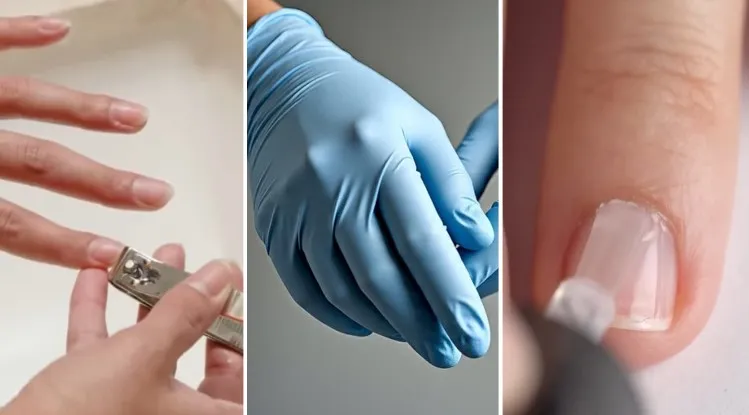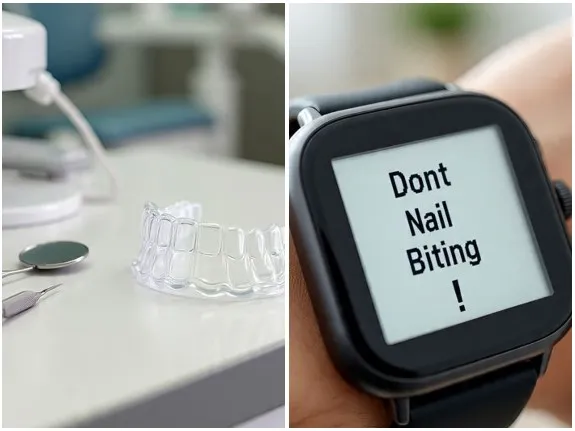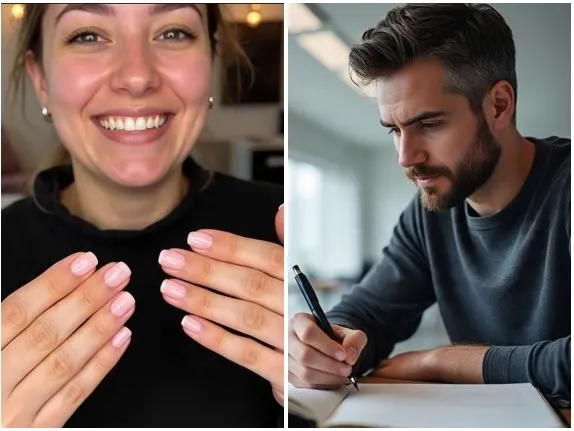How to Stop Nail Biting: 4 Proven Tips for All Ages
We’ve all seen it – or done it. Nail biting, known clinically as onychophagia or onychophagy, is an incredibly common oral compulsive habit. Far more than just a “bad habit,” it’s classified as a body-focused repetitive behavior (BFRD). While often dismissed, it’s important to understand that chronic nail biting can lead to real physical harm and emotional distress.
If you’ve been trying to stop nail biting your without success, you’re not alone. Breaking this cycle isn’t just about aesthetics; it’s about health and well-being. Whether you’re a parent concerned about your children, a teen struggling, or an adult looking to finally quit, effective strategies exist — and Soezi’s press-on nails for nail biters is the game-changing solution that’s revolutionizing how we think about nail care and habit-breaking.
Why People Bite Their Nails
A. General Reasons
For many, it’s an automatic response to stress, anxiety, boredom, or frustration. It can be a subconscious way to seek stimulation or relieve tension, acting as a coping mechanism or oral fixation. Often, it happens mindlessly during activities like speaking, eating, drinking, reading, or watching TV. Identifying these moments is crucial.
B. In Children & Teens
Kids and teens often bite due to nervousness, anxiety, curiosity, or as self-soothing. They may mimic others or do it without thinking. Boys and girls alike might not even realize they’re doing it until a parent, teacher, or coach points it out. Emotional distress like feeling insecure, bored, or hungry can be triggers.
C. In Women
Women frequently link nail biting to stress/anxiety and emotional regulation, often compounded by appearance-focused stress. The desire for good-looking nails can be both a trigger (seeing imperfections) and a strong motivation to stop.
D. In Men
For many men, nail biting is highly habitual and unconscious, linked to focus, tension release, or simply boredom. It’s often less tied to appearance concerns initially, making awareness of the behavior itself key.
When Nail Biting Becomes a Problem
While common, nail biting crosses a line when it causes:
- Physical injury: Sore, bleeding, or broken skin around the fingernails and cuticles.
- Significant embarrassment, shame, or social withdrawal (avoiding handshakes, hiding hands).
- Interference with daily activities (e.g., typing on a keyboard, playing instruments).
- Signs of infection (redness, swelling, pus).
- Potential indication of deeper psychological concerns like obsessive-compulsive disorder (OCD), other body-focused repetitive disorders (BFRDs) like trichotillomania or excoriation disorder, or significant anxiety disorders.
Harms and Health Risks
The consequences extend far beyond unsightly nails:
- Damaged Nails & Skin: Biting can deform the nail bed, cause the nails to grow abnormally, (if you’re struggling with ugly or damaged nails, here’s how to fix them and damage surrounding tissue. Perionychophagia (biting the skin around the nail) and dermatophagia (biting the skin) create tiny cuts vulnerable to bacterial and fungal infections like paronychia. Warts are also a risk.
- Dental Issues: Biting can chip, crack, or break teeth, cause malocclusion (misalignment, especially of anterior teeth), and strain the jaw (bruxism can co-occur). Gingival injury is also possible.
- Germ Transfer & Illness: Fingernails are notorious germ hideouts, picking up viruses and bacteria from surfaces like doorknobs and subway rails. Biting transfers these directly to the mouth, increasing the risk of colds, stomach bugs, and even pinworms. Swallowed nail pieces can cause stomach problems.
- Infection Vector: Saliva can redden and infect the delicate skin around nails.
- Emotional Toll: Chronic feelings of guilt, shame, and the need to hide hands significantly impact self-esteem and quality of life.
Proven Strategies to Stop Nail Biting
1. Prevention Strategies for All Ages

- Keep nails trimmed short: Clipped, trimmed nails are less tempting and offer less to bite. Use scissors or clippers precisely.
- Create a physical barrier: Wear gloves or bandages, use nail covers or stickers, especially during high-risk times (like watching TV). This provides a hint or wakeup call.
- Apply a deterrent: Use bitter-tasting nail polish (anti-biting polish) containing denatonium benzoate. Reapply frequently for maximum effect. A DIY solution of salt water (excess salt granules create a sting) or carefully applied jalapeño/pepper juices (ensure no allergic reaction, avoid rubbing your face, wash off before eating or going out of the house) can work, but beware spicy residue and potential mess.
- Address Sensory Needs: If sensory triggers like rough edges (touch) are a problem, gently file nails smooth. Keep hands moisturized to prevent rough skin.
2. Habit Reversal Training (HRT) – Research-Based & Effective (Especially for Kids)

HRT is a gold-standard behavioral therapy technique:
- Step 1: Awareness Training: Help the individual notice and realize when they bite. Parents can use a gentle code word or secret sign. Track habits using a chart or app. Becoming aware of motor triggers (specific postures, arm movements) or setting triggers (places, situations) is key.
- Step 2: Replacement Behavior: Find an incompatible action to do for about 30 seconds when the urge hits. This could be making a fist, sitting on hands, holding a stress ball or worry stone, fidgeting with a pen (clicking, not chewing!), wiggling fingers, tugging an ear, taking deep breaths, chewing gum, or drawing. The replacement behavior should provide similar sensory feedback (touch, movement).
- Step 3: Motivation & Encouragement: Use a reward system (stickers, points towards screen time, movies, or dinner) for achieving small goals (e.g., leaving one nail unbitten). Celebrate progress! Avoid punishment; it increases anxiety and can make the behavior sneaky.
3. Treatment Options (When It’s Serious)

If nail biting causes significant psychological distress, infection, or is linked to other conditions (OCD, ADHD, anxiety disorders):
- Behavioral Therapy: Cognitive Behavioral Therapy (CBT) or specialized HRT with a therapist addresses underlying thoughts, beliefs (cognitive triggers), and behaviors. Stimulus control therapy modifies triggers.
- Medication: In severe cases linked to impulse control disorders, medications like N-acetylcysteine (NAC), a glutamate modulator, may be prescribed under medical supervision. This is rare and not a first-line treatment.
- Support: Support groups or involving supportive family members, friends, or teachers can be beneficial.
- Digital Tools: Habit-tracking apps, smart watch applications, or simple reminders (timer) can aid awareness.
- Dental Devices: A dental deterrent device can physically prevent biting.
- Consult a Professional: If concerned about infection, see a dermatologist or healthcare provider. If emotional distress is severe, contact your doctor or a mental health professional.
4. Gender-Sensitive Approach

- For Women: Leverage the desire for attractive nails. Schedule manicures or decorating nails as a reward. Focus on identifying and managing emotional triggers through mindfulness or mindset practice.
- Scheduling a regular manicure not only boosts confidence but also discourages biting. Try this quick at-home manicure guide and if you love nail designs!
- For Men: Focus on interrupting the automatic pattern. Use fidgeting tools (pen, stress ball) and create mental awareness of the behavior and its physical damage. Frame stopping as gaining control.
Nail biting (onychophagia) is a prevalent issue across all age groups, from young children to adults. While common, it’s not harmless, posing risks to physical health and emotional well-being. The good news? Research-based methods like prevention tactics, Habit Reversal Training (HRT), behavioral therapy, and targeted approaches for different groups offer real hope.
Change takes time and effort – it’s rarely achieved cold turkey. Focus on small goals, celebrate progress (not perfection!), and utilize support. Whether you’re a parent helping a child, a teen wanting better nails, or an adult ready to break an ingrained habit, identifying your triggers and finding the right replacement behavior empowers you to stop, manage, and ultimately overcome nail biting for stronger, longer, healthier nails and greater confidence. Don’t hesitate to seek help if needed – you can do this!







